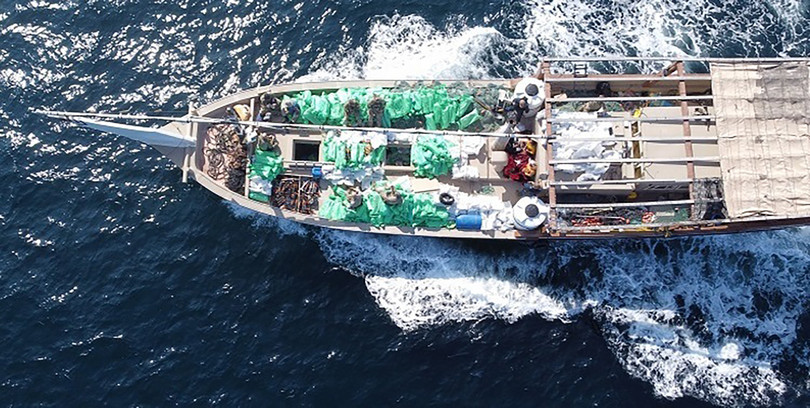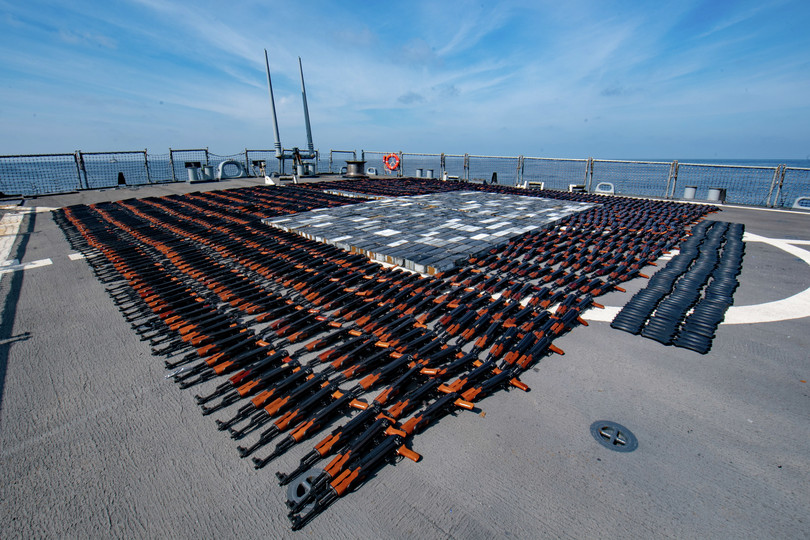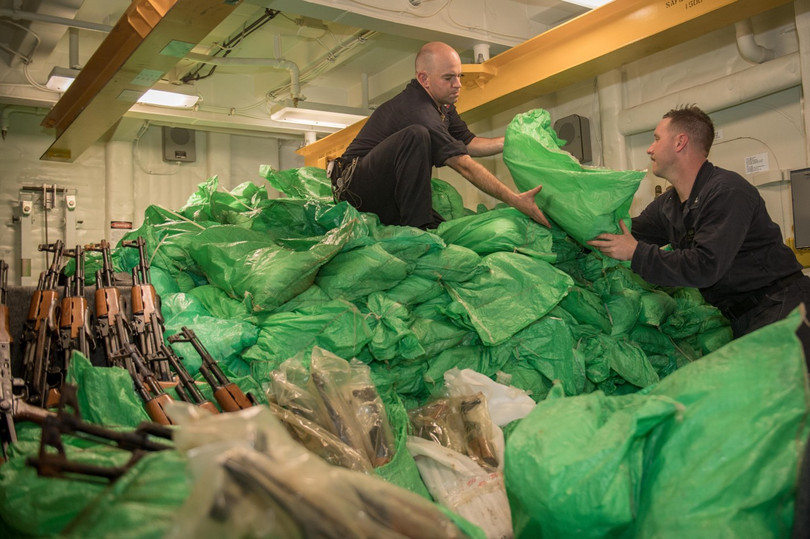The maritime interdiction of over a thousand assault rifles en route to Yemen is the latest iteration of Iranian state-sponsored arms smuggling.
On 20 December 2021, US naval forces intercepted a stateless fishing dhow in the northern Arabian Sea. In what was described as a ‘flag-verification boarding’, intended to establish the origins of the vessel,1 a cargo of 1 400 assault rifles and over 200 000 rounds of ammunition were discovered. The US navy reported that the weapons are likely to have originated in Iran, as this maritime route has historically been used to traffic weapons to Houthi rebels in Yemen, in violation of both UN Security Council Resolutions and US sanctions.2
This is the thirteenth such interdiction by international naval forces since September 2015 of weapons shipments believed to have been destined for Houthi insurgents in Yemen. In two prior incidents, maritime interdictions of arms-smuggling dhows were carried out by the USS Winston Churchill (11–12 February 2021) and the USS Monterey (6–7 May 2021), off the coast of Somalia and in the Arabian Sea, respectively.
Preliminary images of the December 2021 seizure released by the US Navy indicate that it matches the pattern of earlier maritime interdictions. In particular, the guns onboard seem to be Type 56-1 assault rifles – Chinese-manufactured AK-type rifles characterized by their under-folding metal stocks. The two previous interdictions in 2021 also resulted in the seizure of several thousand of these Type 56-1 rifles, as well as a range of heavier weapons. The green packaging in which the weapons were stored aboard the dhow is also similar to the packaging used to encase the Type 56-1 rifles seized in separate incidents in 2018 and 2021.3 It is unusual, however, that the most recent seizure also contained ammunition as well as rifles, something that has rarely been seen in earlier interdictions.
Analysis of earlier arms shipments that appear similar to the December 2021 seizure suggests they are likely to be Iranian state supplies being provided to Houthi allies in Yemen. Previous GI-TOC analysis has found that these Type-56-1 rifles have later been documented in illicit markets across Somalia. 4

A dhow found to be carrying 1 400 assault rifles, believed to be travelling from Iran to supply Houthi rebels in Yemen in December 2021. The green packaging seen on the deck of the ship is consistent with previous seizures of this kind.
Photo: US Navy
Known maritime seizures of arms-trafficking dhows, 2015–2021
| DATE | INTERDICTING AUTHORITY | LOCATION | MATERIAL SEIZED | |
|---|---|---|---|---|
| 1 | 24 Sep 2015 | HMAS Melbourne | Arabian Sea, off the coast of Oman* | 75 anti-tank guided missiles (Toophan/ M113 Konkurs/ 9M133 Kornet variants). |
| 2 | 27 Feb 2016 | HMAS Darwin | Arabian Sea, off the coast of Oman* | 1 989 AK-pattern assault rifles; 49 PKM light machine guns; 100 RPG launchers; 20 60-mm mortars tubes. |
| 3 | 20 Mar 2016 | FS La Provence | Gulf of Aden* | 1 998 AK-pattern assault rifles; six PKM light machine guns; 64 Hoshdar-M sniper rifles; 100 PRG launchers; 20 60-mm mortars; nine 9M113 Konkurs or 9M133 Kornet variant anti-tank guided missiles. |
| 4 | 28 Mar 2016 | USS Sirocco | Persian Gulf or Arabian Sea | 1 500 AK-pattern assault rifles; 21 DShK-pattern heavy machine guns; 200 RPG launchers. |
| 5 | 28 Aug 2018 | USS Jason Dunham | Gulf of Aden* | Over 2 522 AK-pattern (Type 56-1) assault rifles. |
| 6 | 25 Jun 2019 | HMAS Ballarat | Gulf of Oman* | 697 bags ammonium nitrate fertilizer; 475 000 rounds small calibre ammunition. |
| 7 | 25 Nov 2019 | USS Forrest Sherman | Arabian Sea | 21 ‘Dehlavieh’ anti-tank guided missiles; components for the Quds-1 land attack cruise missile, for a C802 anti-ship cruise missile and for a third, unidentified cruise missile; two previously unknown surface-to-air missiles. |
| 8 | 9 Feb 2020 | USS Normandy | Arabian Sea | 150 ‘Dehlavieh’ anti-tank guided missiles; three 358 surface-to-air missile; various optical sights. |
| 9 | 17 Apr 2020 | Saudi-led coalition forces | Gulf of Aden* | 3 002 Type 56-1 rifles, other unknown materiel. |
| 10 | 24 Jun 2020 | Saudi-led coalition forces | Gulf of Aden* | 1 298 AK-pattern rifles (mostly Type 56-1s); RPG-29 variants; ‘Dehlavieh’ anti-tank guided missiles; PKM-pattern light machine guns; DShK-pattern heavy machine guns, optical sights; AM-50 Sayyad anti-material rifles; Walther air rifles. |
| 11 | 11–12 February 2021 | USS Winston Churchill | Indian Ocean* | ~3 700 AK-pattern assault rifles, 100 PKM-pattern light machine guns, 200 PKM spare barrels, 80 DShK-pattern heavy machine guns with spare barrels, 25 DShK-pattern heavy machine guns mounts, 50 12.7 mm sniper rifles with optics, 90 RPG launchers. |
| 12 | 6-7 May 2021 | USS Monterey | Arabian Sea* | 2 555 Type 56-1 rifles, 35 AKS-74U rifles, 194 RPG launchers, 192 PKM light machine guns, 100 SVD-pattern sniper rifles (plus optics), 52 AM-50 Sayyad anti-materiel rifles, 51 AM-50 Sayyad POSP optics, 48 anti-tank guided missiles. |
| 13 | 20 Dec 2021 | USS Tempest and USS Typhoon | North Arabian Sea | 1 400 assault rifles, seemingly Type 56-1s. 226 600 rounds of ammunition |
NOTE: * Indicates seizures shown on the map.
SOURCE: UN Panel of Experts on Yemen, US Central Command, Australian Navy, GI-TOC.

The 1 400 assault rifles seized from the dhow and the rounds of ammunition aboard a US naval vessel.
Photo: US Navy
The evidence for Iranian state-supplied arms
The civil war in Yemen – which first erupted in late 2014 when Houthi insurgents captured large parts of the country – has become a key battleground for proxy conflict between Iran and Saudi Arabia. The Saudi-backed coalition of forces fight in support of the internationally recognized government of Yemen, while evidence suggests that the Houthis have received support from Iran.
A portion of this Iranian support has consisted of deliveries of small arms and light weapons to Yemen,5 carried out by sophisticated, transnational maritime-trafficking networks. Frequent meetings and transhipments between dhows of Iranian, Yemeni and Somali origin disguise the provenance of weapon shipments and evade detection.6
Three pieces of evidence point to the intercepted weapons coming from Iranian state supplies. First, analysis of the serial numbers of the Type 56-1 rifles seized in February and May 2021 shows that the numbers run almost consecutively, which suggests that they could have formed part of a state-to-state transfer from China (where these weapons are manufactured) to Iran.7 While state-to-state weapons transfers would be expected to contain newly manufactured weapons with a continuous run of serial numbers, stock assembled from black-market trading would probably have a wider range or more random distribution of numbers. Second, most of the seizures since late 2015 have also contained weapons manufactured in Iran itself.
Figure 1 Proximity of the serial numbers of rifles seized by the USS Jason Dunham and USS Monterey.
NOTE: To facilitate graphical presentation, each data point represents the averaged value of a group of 25 serial numbers. The proximity of the serial numbers (of the entire shipment in the case of the USS Jason Dunham seizure, and in two clusters in the USS Monterey seizure) suggests the weapons come from state stockpiles.
Third, GPS information from several seized arms-trafficking dhows suggests that the vessels had travelled from Iran in the days before their interception. For instance, a GPS device onboard one of two dhows intercepted by US forces in February 2021 contained coordinates from late January 2021 that corresponded to a small anchorage lying roughly 10 kilometres east of Jask, a strategically important port near the Strait of Hormuz that is host to an Iranian naval base.8
The Wall Street Journal reported in January 2022 that a draft report prepared by the UN Security Council’s Panel of Experts on Yemen identified Jask as the origin point for multiple weapons shipments to Yemen, citing interviews with the Yemeni crewmembers and data from navigational devices onboard the dhows.9
The Type 56 rifle is a Chinese copy of the Soviet-manufactured AKMS assault rifle, first produced in 1956. The primary feature distinguishing the Type 56-1 model from other Type 56 rifles is the stock, which folds beneath the rifle making it easier to carry.
Spillover into Somalia
Between December 2020 and August 2021, GI-TOC field researchers documented a total of 417 small arms and light weapons in Somalia by surveying 13 different locations. Some 38 of these (9.1% of the total) were Type 56-1 rifles and were found in eight of the locations.
The serial numbers of the Type 56-1 rifles found in Somalia clustered around those documented in various maritime seizures, suggesting a common source. As noted above, corroborating evidence strongly indicates that common source to be Iranian state arsenals.
It remains difficult to know exactly when and how the rifles reached Somalia. It is open to speculation whether they were trans-shipped from Iranian consignments en route to Yemen, or diverted into the illicit arms market only after reaching Yemen. Regardless, it is likely that some of the rifles being transported by the vessel intercepted last December may also eventually have found their way to Somalia.
The December 2021 interdiction
Following the December 2021 interdictions, the US Navy determined that the vessel was ‘a hazard to navigation for commercial shipping’ and sank it.10 The five crewmembers of the dhow intercepted in December 2021 all identified themselves as Yemeni nationals and were subsequently handed over to Yemeni authorities.11 This represents a departure from previous practice, where arms-trafficking vessels and their crews have been released following the seizure of their cargoes. The weapons, meanwhile, were transferred to a US guided-missile destroyer. There has been pressure on international forces by external observers – such as the UN Panel of Experts on Somalia – to preserve seized weapons for documentation and analysis, in cases such as this.12
Evidence suggests that trafficking networks have repeatedly used the same dhows to transport multiple weapons shipments. For example, one of the two dhows intercepted in February 2021 – the Umm-al-Mada’in – was identified by a GI-TOC source familiar with maritime arms-smuggling gangs in both Yemen and Somalia as the same dhow intercepted just two months later by international forces.13
The sinking of the latest intercepted vessel perhaps indicates a shift in approach by international forces operating in the Arabian Sea and western Indian Ocean (to intercept arms and drugs shipments) towards preventing the same vessels from being used in multiple trafficking incidents.

The green packaging found aboard the dhow interdicted by the USS Jason Dunham on 28 August 2018 (pictured) is consistent with the most recent seizure and another in 2021.
Photo: Class Jonathan Clay/US Navy
The regional ramifications
The supply of weapons to Yemen sustains a civil war that has led to one of the world’s worst ongoing humanitarian disasters. Over 20 million people are estimated to need humanitarian assistance or protection, and UN agencies operating in Yemen warned in late December 2021 that 8 million people of these will receive reduced food rations from the start of 2022 as a result of budget shortfalls.14
The proliferation of arms in Somalia, diverted from Yemen, also has potentially serious security implications for the African country, as well as for neighbouring Ethiopia and Kenya. The militant groups al-Shabaab and the Islamic State in Iraq and the Levant faction operating in Somalia’s Puntland region routinely source small arms and ammunition from Yemen.15
Notes
-
Under article 110 of the UN Convention on the Law of the Sea (1982) warships have a right to conduct such ‘flag-verification boardings’ in international waters in order to verify the flag, or home country, of the vessel. These boardings are widely used in contemporary maritime law enforcement, including by international forces operating in the Arabian Sea and Western Indian Ocean to interdict arms and narcotics flows. See Angeline Lewis, Flag Verification on the High Seas: Understanding Requirements for Masters and Commanders, The International Journal of Marine and Coastal Law, 30, 2, 2015, 335-360. ↩
-
NAVCENT Public Affairs, U.S. Navy Seizes 1,400 Assault Rifles During Illicit Weapons Interdiction, 22 December 2022, https://www.navy.mil/Press-Office/News-Stories/Article/2882679/us-navy-seizes-1400-assault-rifles-during-illicit-weapons-interdiction. ↩
-
Jay Bahadur, An Iranian Fingerprint? Tracing Type 56-1 assault rifles in Somalia, GI-TOC, November 2021, p15, https://globalinitiative.net/analysis/iran-firearms-somalia. ↩
-
Ibid. ↩
-
For an instructive summary of the nature of Iranian support to the Houthis, see Thomas Juneau, How Iran helped Houthis Expand Their Reach, War On The Rocks, 23 August 2021, https://warontherocks.com/2021/08/how-iran-helped-houthis-expand-their-reach. ↩
-
As the GI-TOC has previously reported, at least one Somalia-based network is involved in trafficking weapons from Iran to Houthi rebels; see Jay Bahadur, Snapping back against Iran: The case of the Al Bari 2 and the UN arms embargo, GI-TOC, November 2020, https://globalinitiative.net/analysis/iran-pb. ↩
-
Although Iran was under a UN arms embargo until October 2020, restrictions on exports to the country did not extend to small arms and light weapons. Therefore, no legal barriers existed to prevent China from supplying Type 56-1 rifles to Iran. ↩
-
Jay Bahadur, An Iranian Fingerprint? Tracing Type 56-1 assault rifles in Somalia, GI-TOC, November 2021, p21, https://globalinitiative.net/analysis/iran-firearms-somalia. ↩
-
Benoit Faucon and Dion Nissenbaum, Iran Navy Port Emerges as Key to Alleged Weapons Smuggling to Yemen, U.N. Report Says, The Wall Street Journal, 9 January 2022, https://www.wsj.com/articles/iran-navy-port-emerges-as-key-to-alleged-weapons-smuggling-to-yemen-u-n-report-says-11641651941. ↩
-
NAVCENT Public Affairs, U.S. Navy seizes 1,400 assault rifles during illicit weapons interdiction, 22 December 2022, https://www.navy.mil/Press-Office/News-Stories/Article/2882679/us-navy-seizes-1400-assault-rifles-during-illicit-weapons-interdiction. ↩
-
Ibid. ↩
-
Ibid. ↩
-
Information provided by a maritime source with knowledge of arms-trafficking operations in Yemen and Somalia, 21 July 2021. The second dhow that was intercepted in February 2021 by the USS Winston Churchill trafficking weapons was also intercepted for a second time. In January 2022, the US Navy intercepted this dhow carrying 40 tonnes of an agricultural fertilizer that is also used as an explosives precursor. See more at: NAVCENT Public Affairs, U.S. Navy Interdicts Stateless Vessel Previously Caught Smuggling Weapons, 23 January 2022, https://www.dvidshub.net/news/413267/us-navy-interdicts-stateless-vessel-previously-caught-smuggling-weapons?fbclid=IwAR3b2tiqr2XNXheT3-bBenpXtRywzyDl5mVfJ1aaBcHQW7SI6PcE3UYEw3Y#.Yezy0FZuxvk.facebook. ↩
-
UN Office for the Coordination of Humanitarian Affairs, Yemen: Humanitarian Response Snapshot (October 2021), 8 December 2021, https://reliefweb.int/report/yemen/yemen-humanitarian-response-snapshot-october-2021; UN News, Yemen alert: 8 million face reduced rations amid funding shortages, 22 December 2021, https://news.un.org/en/story/2021/12/1108612. ↩
-
Jay Bahadur, An Iranian Fingerprint? Tracing Type 56-1 assault rifles in Somalia, GI-TOC, November 2021, p21, https://globalinitiative.net/analysis/iran-firearms-somalia. ↩
